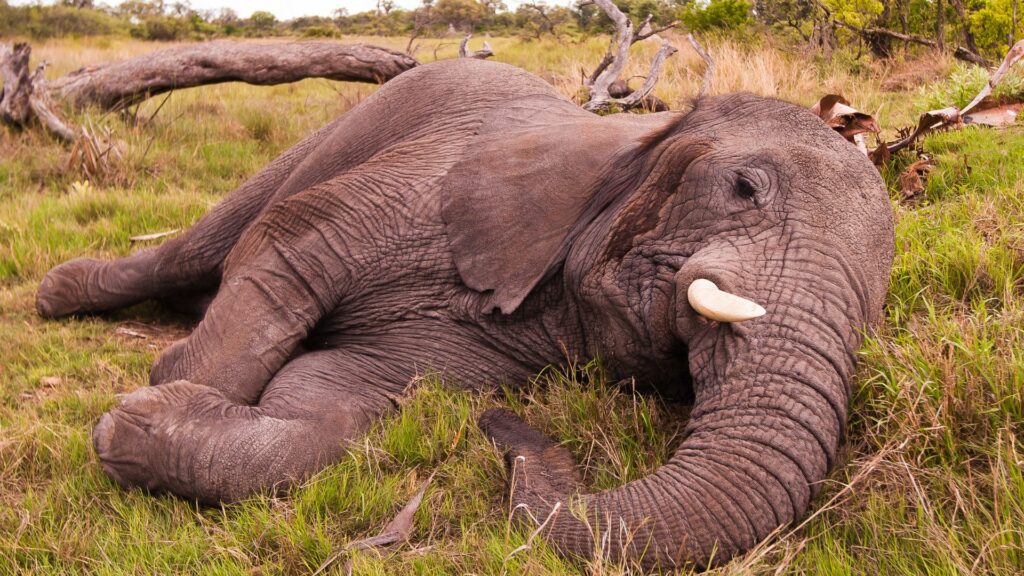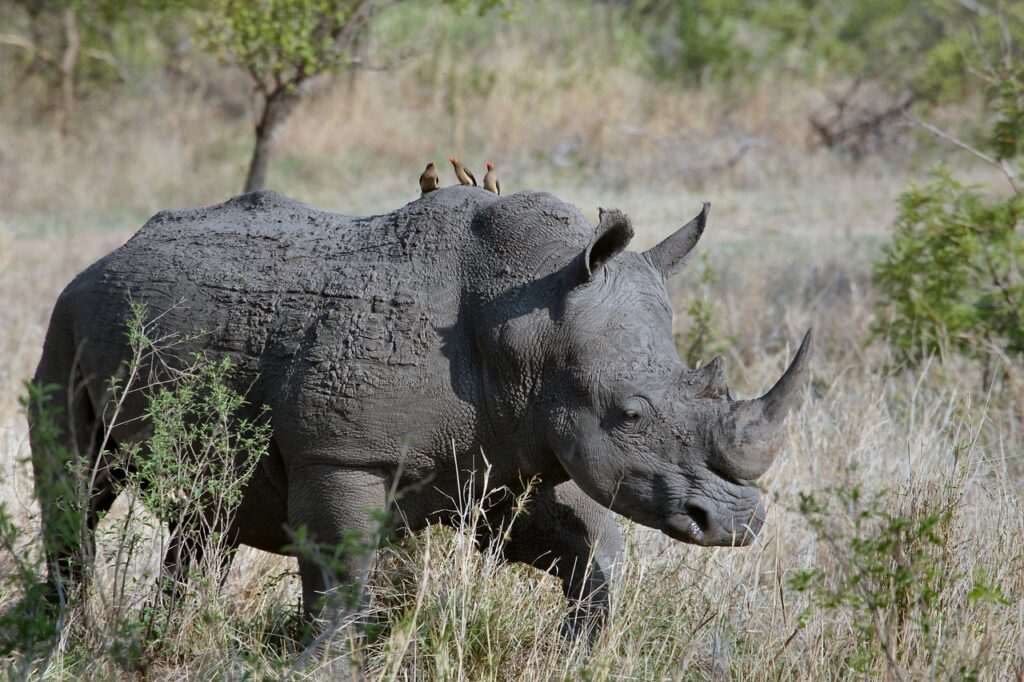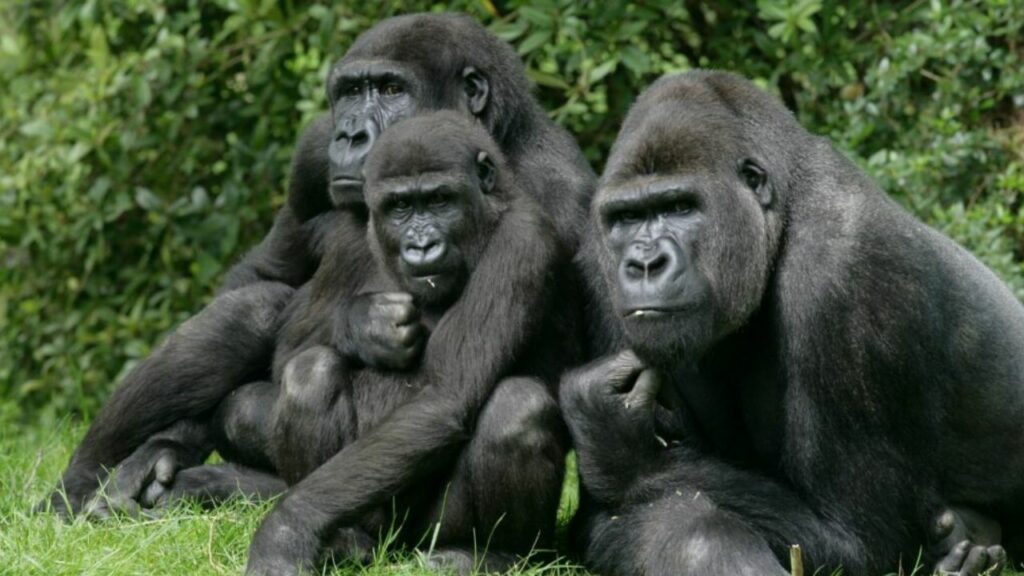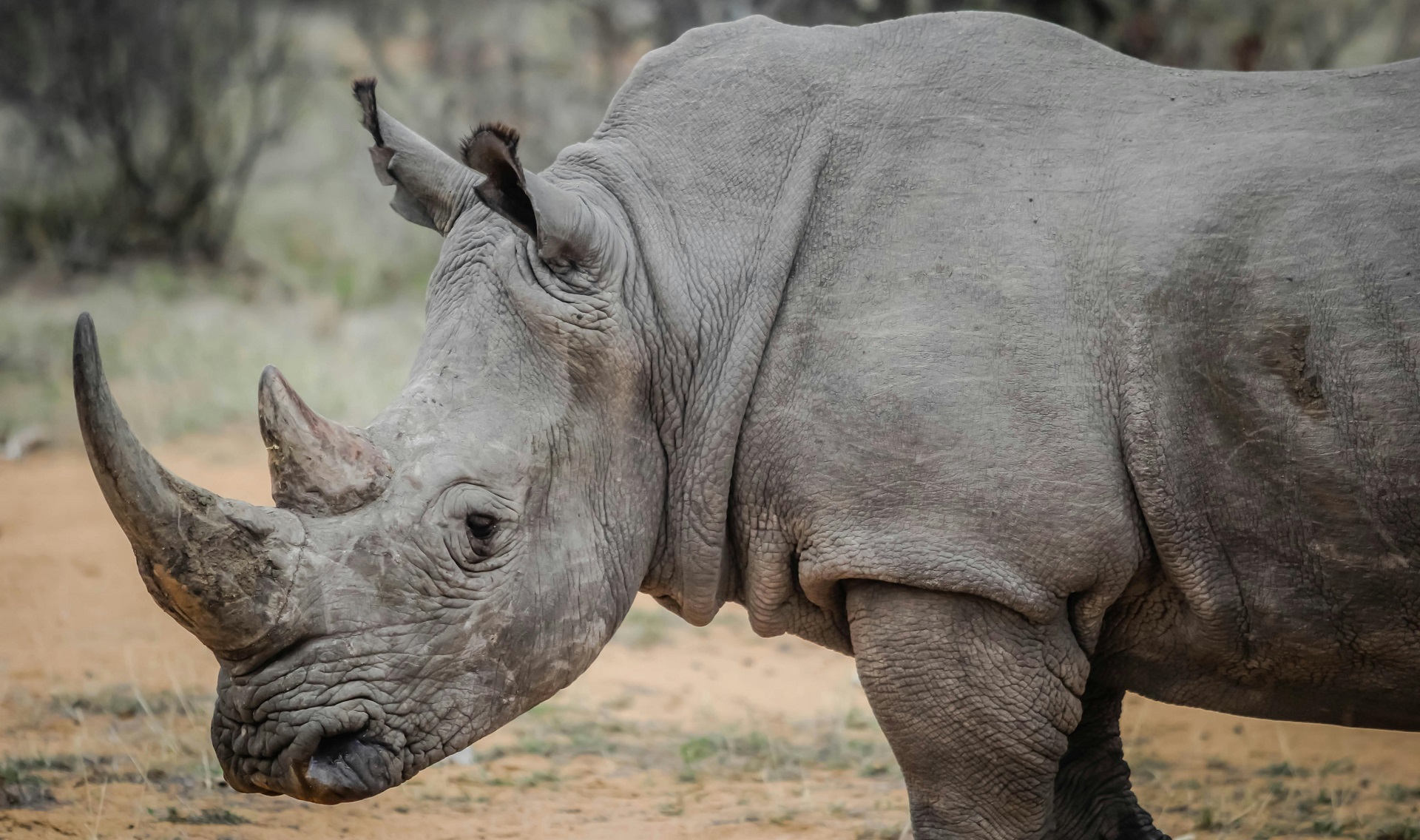Last updated on 29 August, 2024 to reflect the latest research and statistics. Our editorial team has ensured you’re viewing the most current data on this topic. Need help or have a question? Email us.
Do you ever wake up and say, Hey, today I’m gonna snag myself a rhino horn? Or better yet, do a little bit of elephant poaching since there’s such a huge demand despite the Wildlife Conservation Society saying we’ve endangered animals to the brink of extinction.
Poaching doesn’t just happen to South Africa’s rhino population or on safari to Kruger National Park. It occurs worldwide in many animal species. It promotes wildlife trophy hunting and illegal wildlife harvesting. Poaching even happens to fauna.
One of the best ways to stop poaching is to stop buying illegal wildlife parts on international trade. It’s about saying no and holding the poacher and end consumer accountable. Poaching destroys entire animal populations and kills those guardians, risking everything to protect them. It’s done in cold blood!
Poaching statistics reveal a sweeping, multi-billion-dollar crisis. The illegal wildlife trade—valued at $7 – $23 billion a year, kills 20,000+ African elephants annually and has wiped out over 12,000 African rhinos since 2008.
In 2023 alone 586 rhinos (499 in South Africa) were lost, while Brazil sees 38 million wild animals trafficked each year. Beyond wildlife, the toll extends to people: roughly 150 rangers die on the front-line every year protecting vulnerable species.
Most Heartbreaking Facts at a Glance
- Poaching Is a Lucrative Trade Worth $7–$23 Billion Annually
- In Protecting Wildlife, Almost 3 Rangers per Week Are Killed
- The Poaching Rate of Rhinos Is 1 per 15 Hours
- In Vietnam, a Single Pound of Rhino Is Sold From $15,000 to $30,000
- In Botswana, 35,000 Elephants Are Slaughtered Annually
- The average number of tigers in India is 3,682
- Wild Tigers Inhabit Just 13 Countries Around the Globe
- 30,000 Green Turtles Get Poached in Baja, California
Poaching Truths From the Front-Line

According to Save the Rhino, in 2022, South Africa saw a slight drop in rhino poaching, with 448 rhinos killed, three less than the previous year. WWF estimates that every year, over 20,000 African elephants tragically lose their lives to illegal tusk poaching.
According to DFFE, in 2023, 499 rhinos were poached, which is 51 more than the 448 poached in 2022. WWF estimates that every year, over 20,000 African elephants tragically lose their lives to illegal tusk poaching.
One poached animal killed illegally leaves a void in the natural life cycle, animal community, and habitat. That humans continue to bring 30,000 species to the brink of extinction yearly is shamefully tragic!
Poaching Statistics

Poaching Is a Business of Approximately $7–$23 billion per year (ZSL)
The saying that money is the root of all evil is not true! Money helps fund refuge centers, research, and conservation. Some people are the root of evil.
Aside from illegally killing wild animals, poaching is about criminal cartels that benefit at the expense of animals and local communities. Poverty doesn’t create crime; criminals who engage in poaching and black market trade rob poor communities of future opportunities.
Nearly 30,000 Species Are Driven to Extinction Annually (Center for Biological Diversity)
Experts call this Earth’s sixth mass extinction event; we lose three species every hour. It’s unparalleled, and the most recent extinction pattern we can witness is how human arrival in Madagascar wiped out elephants, the dodo, hippos, and lemurs.
Each year, 38 Million Animals get Illegally Trafficked From Brazil (TRAFFIC)
Perhaps you can imagine David Attenborough narrating this in your head: Brazil has the planet’s most significant biodiversity and 13% of the world’s plants and animals. With this excess, poachers hunted and trafficked 38 million animals and destroyed habitats.
In Protecting Wildlife, 150 Rangers Die per Year, Which Is Almost 3 Rangers per Week (Thin Green Line)
The International Ranger Federation believes this number is even higher. Real numbers are challenging even for organizations with boots on the ground. Poachers kill many rangers, and many die accidentally. It’s a dangerous job!
In 2015, 317 Poachers Were Either Killed or Arrested in South Africa (Poaching Facts)
Poaching also kills poachers, and South Africa saw a significant crackdown on illegal wildlife activities, resulting in 317 poachers either facing arrest or being fatally confronted in 2015.
Poaching in Africa Kills 1000 Endangered Species Within a Day (African Wildlife Foundation)
These animals are treading on fragile ground, heading toward extinction due to poaching and wildlife trafficking by criminal syndicates.
- 1000 mountain gorillas remain
- 2000 zebras
- 43% of the lion population vanished in only 21 years
- 97.6% of black rhino deaths since 1960
- 35,000 elephants die every year to poaching
These are poaching facts from 2005 to 2015.
Only Six Countries Have Detailed Poaching Data (Poaching Facts)
These six countries try to manage the poaching problem by keeping semi-accurate figures. Only by monitoring the situation can authorities address the problem and protect natural resources.
- South Africa
- Kenya
- Mozambique
- Namibia
- Botswana
- India
Poaching Stats in Africa Reveal Iconic Animals Are in Danger Because of Poaching (African Wildlife Foundation)
We kill rhinos to treat impotence, elephant ivory tusks for trinkets, lions for fun, tigers for fur, a gorilla for land, zebras for carpets, and sharks for soup.
- Lions, tigers, and hippopotami are vulnerable.
- Elephants, zebra, and gorillas are endangered.
- Rhinoceros are critically endangered.
Instead of Rifles and Guns, Poachers Use Poisoned Arrows To Kill Animals (Hindustan Times)
Poachers use poison arrows for two reasons. One, it doesn’t make a sound and alert conservation officers. Two, furs without bullet damage fetch more in the illegal international trade of endangered wild animal parts.
Poaching In Africa

Over the Past Ten Years, a Total of 9,415 African Rhinos Have Fallen Victim to Poaching. (Save the Rhino)
The rhino crisis took off in 2008 and lasted well into 2015. Numbers have slightly decreased in Africa. South Africa has the most rhinos and has the highest incidents of poached rhinos, reaching 1,000 per year between 2013 and 2017.

At Least 586 Rhinos Were Poached in Africa in 2023 (Rhinos.org)
In 2023, at least 586 rhinos were poached in Africa, which is a 4% rise compared to 2022. Since the poaching crisis began in 2008, over 12,000 rhinos have been killed in Africa. South Africa, home to more than half of the world’s rhinos, experiences the majority of these poaching incidents.
561 Rhinos Were Poached in 2022 in Africa. (Save the Rhino)

In the next decade, African National Parks and their partners plan to rehome and rewild 2,000 rhinos. This effort will be challenging because finding and securing safe, large habitats for these rhinos is difficult.
Total Number of the Population of the Rhino in Africa Is 23,290 (Rhinos.org)
The recent population number of five surviving rhino species is distributed across Africa and Asia, with Africa being home to 23,290 rhinos and Asia accounting for 4,137 of these majestic animals.
In 2015, Poachers Killed 1,349 Rhinos Which Marked the Highest Rhino Poaching Rate in Africa (Save the Rhino)
Kruger National Park is supposed to be a sanctuary for South African rhinos. Rhinos aren’t just eradicated by poaches, but severe climate change is causing periods of drought to hinder their survival further.

The Population of White Rhino is between 1,711 and 1,988 in Kruger National Park in South Africa (SANParks)
The white rhino population has experienced a decline to a range between 1,711 and 1,988 in 2022, while black rhino numbers have decreased to 210 compared to the figures from 2021.

Recent data by South African officials indicates that the rhino numbers in the park have dropped by an alarming 60% since 2013. In 2021, this world-famous park was home to 3,529 South African white rhinos. Additionally, 268 rare black rhinos lived here.
In 2014, 386 Poachers Were Either Killed or Arrested in South Africa (Poaching Facts)
Poaching also kills poachers, and South Africa saw a significant crackdown on illegal wildlife activities, resulting in 386 poachers either facing arrest or being fatally confronted in 2014. This marked a heightened effort to protect the region’s endangered species, especially rhinos, from poaching threats.
Poaching Rhinos Statistics

The Whole World Has Just 27,990 Rhinos (Rhinos.org)
Poaching for rhino horn is the biggest threat to all five rhino species. In the early 20th century, about 500,000 rhinos lived on Earth. Today, due to poaching, there are only around 27,990 rhinos left in the wild.
The Number of Black Rhinos Worldwide Is More Than 6,421 (Save the Rhino)
Thanks to the dedication of African conservationists, who doubled this number from a 20-year low!
The White Rhino Population Is 16,803 (Rhinos.org)
White rhinos are the most populous of the five rhino species, with about 16,803 individuals living across 11 countries in Africa.
Currently, a Rhino is Killed by Poachers Every 15 Hours (Save the Rhino)
On average, one rhino is still poached every 15 hours. Between 2013 and 2017, more than three rhinos were poached every day worldwide. Most of the rhinos poached last year were killed in Namibia and South Africa, where poachers have begun targeting new areas.
According to Rhino Poaching Stats 2020, the Rate of Rhino Poaching in Early 2020 Decreased by 50% Due to COVID-19 (Rhino Review)

Rhinos got a short reprieve from being hunted to extinction in 2020 when curfews made it difficult for syndicates to move rhino goods. Statistics suggest that Africa’s poaching rates dropped from 5.3% to 2.3% in 2021.
However, 2,707 rhinos died from poaching between 2018 and 2021. This number includes white rhinos and critically endangered black rhinos.
The Worst Poaching Catastrophe Was Observed in 2013 When Poaching Spread From South Africa to Kenya and Afterwards From Zimbabwe to Namibia (Save the Rhino)
Rhino poaching increased in South Africa between 2009 -2014. Kenya fell in 2013 with 59 rhinos killed (5% of the rhino populations), then in 2015, Zimbabwe lost 50, and Namibia lost 80 rhinos. The year 2015 was the worst in two decades.
At the start of the 20th Century, There Were 500,000 Rhinos in Africa and Asia (WWF)

This chart visually demonstrates how drastic these events are for thousands of animals and how quickly people destroy an animal.
Vietnam Has the Biggest Rhino Horns Poaching Hub, Where a Single Pound of It Is Sold From $15,000 to $30,000 (African Wildlife Foundation)
An estimate from conservationists indicates that rhino horn fetches an exorbitant price of approximately $60,000-$65,000 per kilogram on the Asian market. With this astonishing value, a stockpile of 30 tonnes could potentially yield a staggering sum of up to $2 billion.
Education has to be the key. Rhino horns are keratin, not a miracle cure for cancer.
By 2030, the Rate of Rhino Poaching Will Increase by 356% (AFW)

Data from AWF indicates that rhino poaching is projected to rise by approximately 356% from 2015 to 2030. Conservationists fear that the rhinos from today won’t live to be accounted for in 2030.
According to recent reports, rhino poaching has declined in some areas due to increased conservation efforts and anti-poaching measures.
Poaching Elephants Statistics

In Botswana, 35,000 Elephants Are Slaughtered Annually (AFW)
The last of the elephants need our help. Poaching is trying to eradicate iconic species, which will soon be distant memories. The demand for ivory still drives elephant poaching, including the 130,000 elephants roaming the African plains.
Do the math:
130,000 elephants − 35,000 killed yearly = not enough time to save them
Really, you need an ivory trinket?
Every 26 Minutes, on Average, One African Elephant Dies for Its Ivory (IFAW)

We kill elephants for ivory. The U.S. banned ivory only in 2016 – shocking! Even if elephants weren’t on the eve of extinction, does it make sense to kill them for a tusk?
With over 20,000 elephants falling victim to poaching annually, urgent action is necessary to prevent their extinction. Shockingly, poachers claim the life of an African elephant approximately every 26 minutes.
The Average Cost of Ivory Has Increased to 1,019% in the Black Market (Bristol University)
Asian markets are driving the demand, and between 1989 and 2014, ivory increased in value. Sadly, ivory is still traded legally, not that it matters since the black market of illegal goods thrives.
The Poaching Rate of African Elephants Was Highest in 2011, Then It Gradually Declined (ScienceDaily)
Despite a reprieve from poaching, the elephant population remains tiny at 350,000 elephants, and 10-15,000 become poaching victims yearly. CITES revealed that 2011 saw a crest of 10% poaching mortality, dropping to 4% in 2017.
Among the 50,000 Elephants Inhabiting Asia Today, 40% of Them Are in Captivity (Poaching Facts)

India trained wild elephants to perform domestic chores and even warfare. Today, 40% of 50,000 Asian elephants live in captivity. Although poaching and legal killing are responsible for their decline, so is habitat loss.
The Number of Elephants Has More Than Doubled in Past 30 Years, From 16,000 in 1989 to 34,800 in 2021 (The Journal of African Elephants)
Kenya knows that a healthy elephant population drives its tourist economy. However, there is a 2.8% elephant growth increase alongside a poaching decline. Isn’t it better to make money off wealthy tourists?
At the start of the 20th Century, There Were 100,000 Elephants in Asia and a Few Million in Africa (IFAW)
The Asian elephant has smaller ears (and other differences) and once had a significant habitat spanning from the Persian Gulf to India and to China. But their numbers have dwindled by 50%, and their habitat shrunk by 15%.
Satao, the Most Adored Elephant in Kenya, Was Killed by a Poacher’s Poisoned Arrow in 2014 (National Geographic)
Satao had something this poaching wanted: a 6.5-foot-long tusk. The poison arrow caused this iconic animal to die a horrific death.
Poaching Tiger Statistics

According to Poaching Stats, the Number of Tigers Has Declined to 5,600 From 100,000 Within a Century (WWF)
India now has the largest tiger population, hosting half of all remaining wild tigers. Much of their decline has happened in the past decade. Tigers have lost 95% of their historical range due to human activity and development.
The Average Number of Tigers in India Is 3,682 (PIB)

An analysis conducted by the Wildlife Institute of India has estimated the tiger population’s upper limit at 3,925, with an average count of 3,682 tigers. This indicates an impressive annual growth rate of 6.1%.
Wild Tigers Inhabit Just 13 Countries Around the Globe (WWF)

We’ve lost 97% of the wild tiger population in the last century. Bangladesh, Vietnam, Cambodia, India, Bhutan, Thailand, Indonesia, Laos, China, Malaysia, Russia, Nepal, and Myanmar are lucky enough to have tigers.
In 2023, 56 Tigers in India Were Killed by Poachers (Wildlife Protection Society of India)
The number has jumped to 56, as the demand for tiger parts, like bone and fur, won’t end. Many more tigers die from other causes, too!
The Most Prominent Threat to Tigers in the Wildlife Is Poaching and Illegal Wildlife Trade (WWF)
Poaching, crime syndicates, illegal black market trade, and the end consumer are killing tigers faster than conservation efforts can establish them.
Poaching Gorilla Statistics

Depending on the Subspecies, All Gorilla Species Fall Either Under the Endangered or Critically Endangered Category (WWF)
We’ve only known about mountain gorilla subspecies since 1902. We’ve subjected them to ruthless illegal hunting and habitat destruction.
Luckily, some conservation efforts are seeing some recovery in Virunga Massif. There are 604 gorillas, part of the rare 1000 gorilla population.
The Western Lowland Gorilla Is the Most Widespread Gorilla Species (WWF)

Counting the lowland gorillas in the dense and remote jungle is difficult. This ape is also a master at hiding, but the best guess suggests 100,000 apes.
People Estimated the Mountain Gorilla Would Become Extinct by the End of the 20th Century (WWF)
Thanks to conservation efforts, the population of mountain gorillas has grown from 620 individuals in 1989 to around 1,004 individuals today.
Poaching Statistics of Other Endangered Animal Species

Wildlife Tourism Is Worth 5 Times More Than the Poaching Industry (Natural Habitat Adventures)
Who knew there was so much money in not killing all the animals and employing 9.1 million people? Wildlife tourism is a prosperous part of the global GDP, In 2023, contributes $ 165.4 Billion to the global GDP and the global wildlife tourism market is projected to reach USD 286.86 billion by 2030.(Research and Markets).
According to 2020 Stats, the Giant Panda Is No Longer an Endangered Species (IUCN)
Yeah! Who doesn’t love a giant panda? These adorable creatures are upgraded (downgraded sounds bad) from endangered to vulnerable.
More Than 1,000 Whales Are Hunted Yearly, Although Commercial Whaling Is Banned Worldwide (IFAW)
Yes, governments and fishing regulators banned whaling in 1986. Yet, we still hunt 1,000 whales for some stupid commercial whaling enterprises. Go whale watching instead of whale killing!
In Baja, California, More Than 30,000 Green Turtles Are Poached Annually (WWF)
These adorable turtles already face a massive survival challenge when they hatch on the dunes of the Baja. Although poaching them for meat is bad enough, thousands die in fishing nets.
There Are Only 10,000 Cheetahs Left in the World Today, As Poachers Have Been Killing Them for Decades (Big Cat Rescue)

Not even the world’s fastest land animal can escape the perils of poaching. In 1970, the cheetah population hovered at 25,000; now, we’re down to 10,000 or 10% from the 1900s. Poachers aren’t their only enemy. Farmers kill to protect their livestock, and we continue encroaching on their habitat.
Almost 100 Million Sharks Are Killed Annually (Al Jazeera)

Wow, these latest figures are one of the most heartbreaking statistics since 100 million is a ballpark figure that experts suggest is tragically low. They fear the number is nearly triple that at 273 million.
Ivory Poaching and Violent Conflicts Are Deeply Connected in Africa (University of Birmingham)
It’s a fact that poachers are criminals, and the illegal ivory trade is a means to an end for gangs who want to control territory.
Chinese Traditional Medicine (TCM)Is Worth $60 Billion Yearly (National Geographic)
Tigers, rhinos, and other exotic animals are dying for an ancient Chinese myth. Science has proven that these remedies don’t work. Yet, in 180 countries, consumers spend $60 billion annually fueling the illegal poaching trade.
In 2022, 125 adult Amur leopards were identified in Russia and 46 in China in 2019 (WWF)

This stunning feline has almost vanished from our planet, and only 125 Amur leopards exist in Russia and 46 in China. Conservation efforts are seeing marginal improvements. However, this feline isn’t out of the woods yet; we continue to destroy its habitat.
FAQs
How Many Animals Are Poached Each Year?
There are 100,000 million sharks, thousands of iconic animals, millions of deer, millions of fish, birds, and exotic animals for the pet trade. The number is astronomical!
What Are Poachers?
Poachers are individuals who illegally kill and capture wild animals, violating the law. They often target animals for their skin and other purposes, such as the illegal drug trade.
Why Are Rhinos Poached?
Rhino poaching is driven by the demand for rhino horn in Asian countries, especially China and Vietnam. While rhino horn is traditionally used in Chinese medicine, it is increasingly being used as a status symbol to display success and wealth.
Wrap Up
The answer to stopping animal poaching is you. Yes, you! One person has the power to make a difference. Stop buying exotic animals, don’t buy trinkets made from ivory or coral, and definitely don’t buy wild animal parts like furs, pangolin scales, or restorative material.
Planet Earth needs you to help end ivory poaching on the beautiful African continent and end the current poaching crisis everywhere.
To make a difference by supporting a conservation society, you help end the illegal trade of rhino horn poaching.
You are the one. Self-included!


